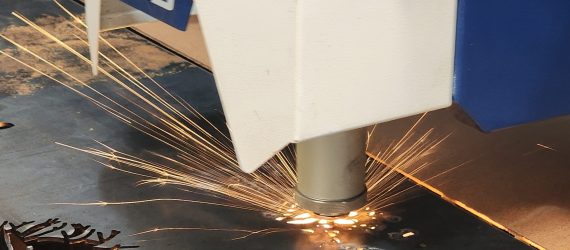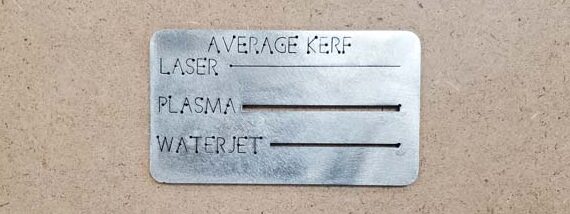
Our team here at Lasersmith Fabrication was very excited to introduce CNC laser cutting to our custom metal fabrication shop over this past year. We’ve been utilizing a plasma table to create metal signs, wall art, trailer parts, and a wide variety of other metal work for several years, but bringing in cutting-edge laser technology has allowed us to dive into even more industries and greatly expand our capabilities.
Lasersmith Fabrication provides high-quality and timely metal shop services in Fort Collins, CO. Whether you need a custom sign for your new business, a run of precise prototype parts, or a quick welding repair, you can count on our team for excellent work at competitive prices. Call us or contact us online to discuss your metal project today.
How Does Laser Cutting Work?

Before we explore the advantages of laser cutting compared to alternatives, you may be curious how, exactly, a CNC laser cutter works. While plasma cutters use electric currents to create plasma arcs that melt and blow away the metal, laser cutters don’t rely on the conductivity of the material being cut. Instead, they use focused laser beams to melt and vaporize the metal to create the cut edge.
Metal shops and other commercial entities use different types of laser cutters depending on the machines they have and what they’re using them for.
CO2 Laser Cutting
One of the most common types is the CO2 laser cutter, which uses a gas mixture containing CO2, nitrogen, and helium. The machine generates a laser beam by stimulating the gas mixture with an electrode, causing the CO2 molecules to produce photons (light particles) that, when focused, create the heat needed to cut through metal.
Fiber Laser Cutting
Another type of laser cutter that is gaining in popularity and use is the fiber laser cutter. This type generates laser beams by amplifying light through a fiber optics cable and focusing the beam onto the piece to be cut. Fiber lasers can produce much smaller spot sizes compared to CO2, which means more accuracy and versatility. The smaller spot size also allows fiber lasers to cut reflective materials, such as copper, brass, and gold.
Fiber laser technology offers several benefits compared to CO2 lasers, including:
- Lower operating costs
- Faster processing times
- More accuracy and reliability
- Superior energy efficiency
- Less maintenance
What Type of Laser Cutter Does Lasersmith Fabrication Use?
Here at Lasersmith Fabrication, we use a 6-kilowatt fiber laser table. Our metal fabricators first design the metal piece using CAD (computer aided design/drafting) software. The CNC (computer numerical control) laser table then uses the cut paths in the design file to guide the laser and cut out the desired piece.
Each project we complete is different, using various thicknesses and types of metal. Our fabricators always take the time to optimize the laser cutting table (pierce height, cutting height, gas pressure, etc.) for the cleanest and most precise cuts possible.
What Are the Benefits of Laser Cutting Versus Alternatives?
Laser cutting provides several advantages compared to alternative cutting methods, such as plasma and waterjet.
1. Smaller Kerf and Tighter Tolerances
Since adding a CNC laser table to our shop, we’ve been able to tackle a wider range of custom metal projects with tighter tolerances and more detailed designs. Cutting precision and accuracy for small, detailed parts and designs depends in large part on the kerf, which is the width of the removed material (the cut line); the smaller the kerf, the more precise the cut. Laser cutters produce very small kerfs, as illustrated in the photo to the right.

2. Smoother Cuts and Less Cleanup

Deburring and cleaning cut pieces is an essential step in any metal fabrication project, especially when using a plasma cutter, which leaves leftover metal called dross behind on the piece. The dross (or slag) must be removed for a clean, smooth finish.
With proper settings, laser cutters leave behind minimal extra material. The piece may even come off of the table smooth, clean, and ready for the next step in the fabrication process with no additional cleanup needed.
3. Faster and More Efficient Process
Speed and efficiency are essential in any metal fab shop, and laser technology provides both. Laser cutting is faster than plasma cutting and uses less energy. Want to see a laser cutter in action? Check out this hyperlapse of our CNC laser table cutting out some metal snow gauges.
Put Our Laser Table To Work With Your Metal Project
If you have a metal project that requires precision laser cutting, you can count on Lasersmith Fabrication. We offer quick and competitively priced laser cutting services for all kinds of projects, from one-off ranch signs to runs of hundreds of custom parts. Call us today to get started. You can also contact us online or visit our shop in Fort Collins, CO.

